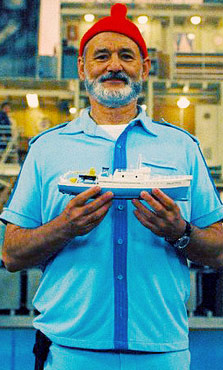 “The Life Aquatic With Steve Zissou” putters along so lifelessly it seems almost impossible that its director is also the man behind the sublime masterpiece “Rushmore”. The drama is contrived, the characters no more than perfunctory swatches of behavior or wardrobe, and every one of Anderson’s attempts at coolness places another stratum of inverted commas around the whole affair. The innocence that was so beguiling in “Rushmore” and “Bottle Rocket” does not translate well into Anderson’s last two films, which attempt to tackle more adult themes. Either the grown-ups in his films have stopped developing emotionally at the age of sixteen or they are caricatures of parental figures as drawn by a small child who can record adult behavior but can’t understand it. “The Life Aquatic With Steve Zissou” putters along so lifelessly it seems almost impossible that its director is also the man behind the sublime masterpiece “Rushmore”. The drama is contrived, the characters no more than perfunctory swatches of behavior or wardrobe, and every one of Anderson’s attempts at coolness places another stratum of inverted commas around the whole affair. The innocence that was so beguiling in “Rushmore” and “Bottle Rocket” does not translate well into Anderson’s last two films, which attempt to tackle more adult themes. Either the grown-ups in his films have stopped developing emotionally at the age of sixteen or they are caricatures of parental figures as drawn by a small child who can record adult behavior but can’t understand it.
None is convincing, needless to say, but particularly so in ‘Life Aquatic’, in which Anderson leaves the movie in the normally capable hands of Bill Murray, who gives possibly the first phoned-in performance of his illustrious career. The laconic demeanor and heavy, watchful eyes, so affecting in both “Rushmore” and “Lost In Translation”, here denote nothing so much as boredom with life. His spirit has gone, and it’s not coming back any time soon. He’s so out of gas during his rampage to rid the Belafonte of pirates that Murray conjures nothing but distracted annoyance, like a man shoveling snow off his driveway after a light storm. A quarter-hour into the meandering story and Murray looks less like a man who’s seen too much and more like a man who feels too little. The oddballs around him—a crackling Cate Blanchett aside—exacerbate his disconnection into complete incoherence.
This film raises alarms about Anderson. To adapt “Rushmore”, there is all the difference in the world between making a film about a dreamy kid who stages a juvenile version of “Serpico” and just filming a juvenile version of “Serpico”. In the first instance, there was some measure of self-consciousness, of paying tribute to the dreams and desires of adolescence while recognizing their bittersweet passage (Anderson even punctuated the point by ending the movie with The Faces’ “Oh La La”, with its line, “I wish that I knew what I know now/When I was younger”). Max Fischer charmed because there was an underlying sense that he was too rare a species to succeed in life, and the film leaves off just as even he might be realizing that.
In the second case, though, there is only a desire to re-establish the lost enchantment of childhood—and the desire seems to be the filmmaker’s, not Zissou’s. “The Life Aquatic”‘s storybook cuteness is not merely the surface of the story, it is the story. Matching uniforms! A cappucino machine on a ship! The Apple II monitors! Bowie in Portugese! It’s eBay on a ship. The beautiful Crayola expanses of land and sea Anderson has painted only draw attention to how void of all mature matter the characters really are. So much color, so little sense of how life is actually lived. This isn’t filmmaking, it’s playing dress-up in the attic on a rainy day. At this rate, perhaps audiences would do well to leave Anderson alone with his toys. I’m sure he wouldn’t notice. |